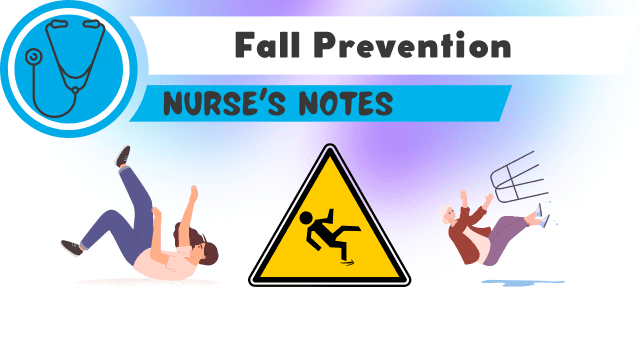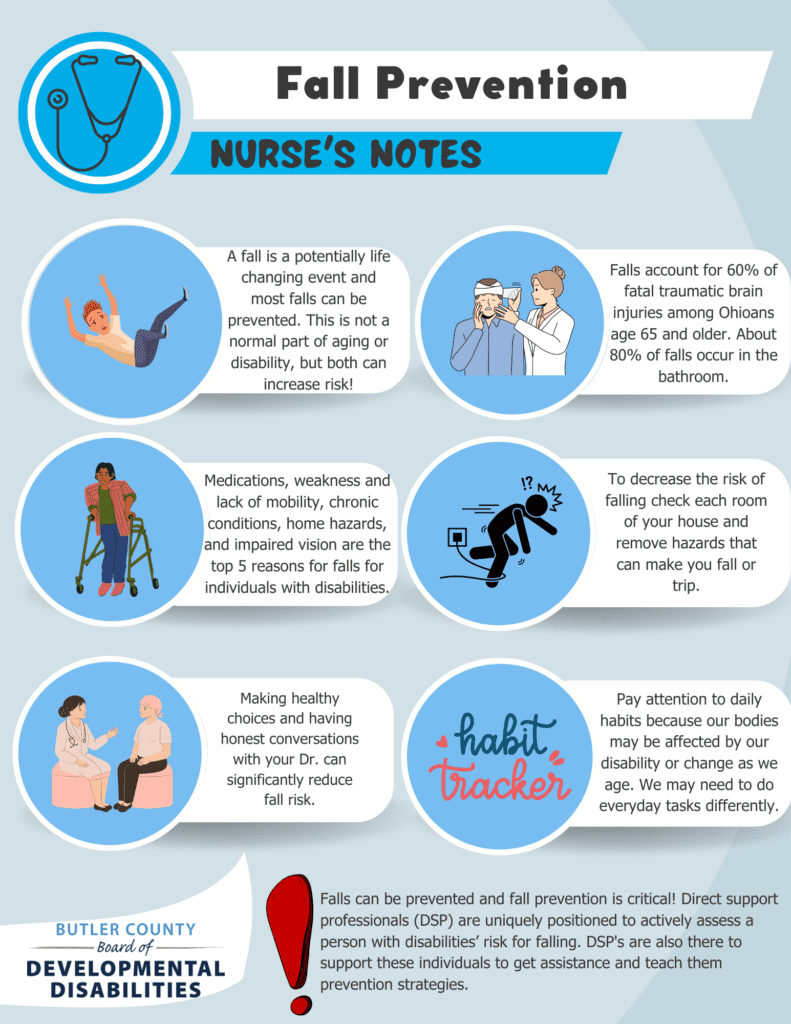
Nurse’s Notes: Fall Prevention
Every 3 months, our staff nurses share important health updates. This month, our nurses are talking about Fall Prevention.
A fall is a potentially life changing event and most falls can be prevented. This is not a normal part of aging or disability, but both can increase risk!
A few facts from the Ohio Department of Health
- Falls account for 60% of fatal traumatic brain injuries among Ohioans age 65 and older.
- From 2010 to 2019, the annual number of fall-related deaths among older adults increased by 55%.
- One in three Ohioans age 65 and older fall each year.
- About 80% of falls occur in the bathroom.
What are the top 5 reasons for falls for individuals with disabilities?
- Medications (types of medications and the number you are taking).
- Weakness and lack of mobility (poor balance, lack of physical activity, fear of falling).
- Chronic conditions (Seizures, Cognitive impairment, Diabetes, Obesity, Breathing problems, etc.).
- Home hazards (indoor and outdoor).
- Impaired Vision (individuals with low vision have two times higher of a chance of falls, multiple falls, and related fractures).
Falls can be prevented and fall prevention is critical! Direct support professionals (DSP) are uniquely positioned to actively assess a person with disabilities’ risk for falling. DSP’s are also there to support these individuals to get assistance and teach them prevention strategies.
To decrease the risk of falls pay attention to the “3 H’s!”
- Home: check each room of your house and remove hazards that can make you fall or trip.
- Health: making healthy choices and having honest conversations with your Dr. can significantly reduce fall risk.
- Habits: our bodies may be affected by our disability or change as we age. We may need to do everyday tasks differently.
Home
- Surfaces: check for rips / loose threads in rugs and carpet, cracks or raised areas in cement, wood or tile floors, remove raised door sills if able.
- Lighting: most homes need more lighting, especially around stairways and walkways. Add nightlights along walkways and floor level lighting for stairs is helpful. Have a lamp or light switch within reach of the bed.
- Rearrange furniture to create straight, clear walkways. Consider getting rid of furniture you don’t use to create more room.
- DECLUTTER: the more things you have, the more things you have to get in your path and cause you to trip. Look for things like trash, paper, cords, boxes, and other things that can block your way, or cause you to trip. Keep papers filed away in a filing cabinet, desk, or plastic storage containers. Keep appliance and telephone cords out of walkways (do not put cords under a rug). Make sure pillows, blankets, and clothes are off the floor.
- When available, always use a handrail.
- Add strip of bright paint on top edge of stairs to create contrast. Use a different color for top and bottom of the stairs.
- Consider using a shoulder bag or backpack to carry things up and down stairs. Be sure the load doesn’t block your view and that one hand is free for the handrail.
- Grab bars in bathroom for getting in and out of tub, up and down off toilet and by the sink.
- Non slip strips or mat on floor of tub / shower and non-slip rug or mat to stand on when getting in and out of the bath.
- Put toiletries and bath items at eye level to avoid bending or reaching for them.
- Keep supplies in bathroom to wipe up spills immediately. Keep towels off the floor.
- Using a raised toilet seat can be helpful.
- In kitchen, keep food, dishes, etc. that you often use at eye / shoulder level.
- Clean up spills immediately. Dry spills like sugar and flour can be as slippery. Wet and sticky spills are just as dangerous as slippery ones.
- Avoid wearing loose fitting clothes that can catch on handles / doors or come in contact with hot items.
- Consider a sturdy stepstool with a handrail for reaching things and for sitting to rest on
- Bedroom: light switches or lamp within reach of bed. Put telephone and flashlight next to bed
- Bed should be at right height. Shouldn’t have to step up or drop down to get in and out of bed. Bed risers may be helpful
- Chairs, sofas, and loveseats should be easy to get in and out of. Can purchase chair risers
- Consider use of cane or walker if you are frequently using walls or furniture to steady yourself as you walk around
- Even when relaxing at home, wear shoes or slippers that fit well, wrap around the heel, and have nonskid soles. Do not walk around your home in socks, stockings or bare feet.
Health
Talk with your Dr. about:
- Assistive devices that may be helpful
- Recommend exercises for me
- Are there community resources or classes that can help reduce my risk for falls
- Can you refer me for a home health assessment to reduce fall risks in my home?
- Treatment options for chronic pain and impact on fall risk
- Strategies for sleeping well to have energy and alertness to stay safe
- Review my medications for fall risk
- Vision and hearing exams
- Talk with your Dr. about symptoms or falls you’ve had even if they don’t ask. Examples fear of falling, near falls or trips, dizziness, muscle weakness, difficulty doing daily activities, etc.
Habits
Things we do every day can affect risk for falls. Starting a few good habits and dropping a few bad ones can help.
- 15 minutes of simple exercise every day
- Balanced diet and stay hydrated
- Slow down and think about the task at hand before doing it. Consider falls when planning how to do something
- Stop at curbs / ramps and consider height before stepping down or up
- Keep one hand free for balance, even if it means making more trips
- Move slowly when getting out of bed or chair
- When you get out of a car, swing both legs out, place both feet on the ground and use your hands for support.
- Allow people to help you and ask for help if needed
If you have pets:
- Don’t step over them. Make them move.
- Check to see where pets are before walking, especially near steps or doorways.
- Train your pet to not jump on you when standing.
- Keep water, food bowls, toys and beds out or your path.

Sources:
https://aging.ohio.gov/care-and-living/health-and-safety/fall-prevention/pets-and-falls
https://dodd.ohio.gov/health-and-welfare/toolkit/toolkit-falls-prevention
